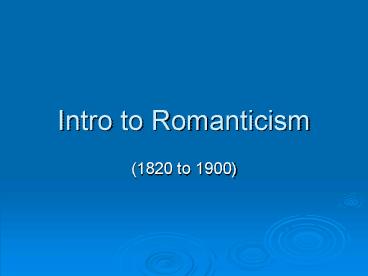Intro to Romanticism - PowerPoint PPT Presentation
1 / 13
Title:
Intro to Romanticism
Description:
1830- Revolutions begin in France, Belgium, and Poland. 1831- Victor Hugo writes The Hunchback of Notre Dame. 1837- Queen Victoria crowned in England ... – PowerPoint PPT presentation
Number of Views:96
Avg rating:3.0/5.0
Title: Intro to Romanticism
1
Intro to Romanticism
- (1820 to 1900)
2
Time line of the Romantic Period
- 1823- The Monroe Doctrine
- 1830- Revolutions begin in France, Belgium, and
Poland - 1831- Victor Hugo writes The Hunchback of Notre
Dame - 1837- Queen Victoria crowned in England
- 1837- Dickens publishes Oliver Twist
- 1842- The New York Philharmonic is founded
- 1844- Dumas writes The Three Musketeers
3
Time line of the Romantic Period
- 1845- Poe publishes The Raven
- 1846- The planet Neptune is discovered
- 1848- Karl Marx publishes The Communist Manifesto
- 1859- Darwin publishes The Origin of Species
- 1861-1865- American Civil War
- 1870- Franco-Prussian War
4
Time line of the Romantic Period (1820-1900)
- 1876- Alexander Graham Bell invents the telephone
- 1884- Mark Twain publishes The Adventures of
Huckleberry Finn - 1889- Van Gogh paints The Starry Night
- 1893- Edvard Munch paints The Scream
- 1898- Spanish American War
5
Romantic Music
- Has a few similarities with classical music
- Uses all classical forms
- Generally homophonic
- Some composers remained rooted in the classical
tradition, others were more revolutionary - Schubert, Brahms, Mendolssohn were more
traditional - Berlioz, Liszt, Wagner were less so
6
Romantic Music
- Individual styles
- Romantic music is much more focused on
self-expression and individuality - It is much easier to tell composers apart
- Reflects their own personality
- Expression
- Explored a wider range of emotions and delved
deeper into those emotions - Romantic love is glorified in opera and songs
- Fascination of the diabolical and the fantastical
- Most composers influenced by nature
7
Romantic Music
- Nationalism and Exoticism
- Nationalism is a piece created with a national
identity-uses folk tunes, dances, legends from a
composers homeland - Exoticism is the use of music evoking foreign
lands- Used rhythms, melodies, and instruments
from foreign lands - Program Music
- Program music is instrumental music that is
associated with a story, poem, idea, or scene - Music became closely associated with literature
8
Structure of Romantic Music
- Timbre
- Orchestra was larger (up to 100 people)
- Brass, woodwind, and percussion expanded to allow
for new sounds - Harmony
- Use of chromatic harmony became prevalent
- Dissonance was used much more freely
- Uses a wider variety of keys and modulations
- Tonic key is less clear than in previous eras
9
Structure of Romantic Music
- Dynamics, Pitch, Tempo
- Wider range of dynamics, including ffff and pppp
- More frequent use of crescendos and decrescendos,
as well as sudden changes - Use of rubuto to intensify expression
- Expanded pitch range
10
Expansion, and miniaturization, of Forms
- Shortening
- Shorter works are only a few minutes.
- Meant to be heard in an intimate surrounding
- Often create intense mood through a melody and a
few chords - Expansion
- Symphonies may last 45 minutes to an hour
- Thematic Transformation became a common tool in
extending works - Larger operas and orchestral works could last
hours
11
Music and the Public
- Composers were inspired by Beethoven to be
freelance composers - Composers wanted to write to fulfill some inner
need, to be judged favorably be their
contemporaries and by history - Various wars in Europe caused hardship for the
aristocrats, who could no longer afford to hire
composers and orchestras - As borders changed, positions for composers
disappeared
12
Music and the Public
- Composers wrote for the expanding middle class,
and subscription concerts became commonplace - Major US conservatories founded in 1860s
- Women could study as well
- The piano became a fixture in the home, so
orchestra and opera works were transcribed to
piano music
13
Music and the Public
- Few composers could support themselves only
composing - Franz Liszt and Niccolo Paganini were in demand
as virtuoso performers - Frederic Chopin charged high fees for piano
lessons - Hector Berlioz and Robert Schumann were critics
for music publications - Felix Mendelssohn and Gustav Mahler were
excellent conductors































